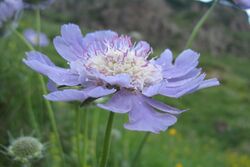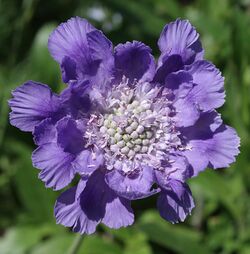Biology:Lomelosia caucasica
| Lomelosia caucasica | |
|---|---|

| |
| Lomelosia caucasica (syn. Scabiosa caucasica) | |
| Scientific classification | |
| Kingdom: | Plantae |
| Clade: | Tracheophytes |
| Clade: | Angiosperms |
| Clade: | Eudicots |
| Clade: | Asterids |
| Order: | Dipsacales |
| Family: | Caprifoliaceae |
| Genus: | Lomelosia |
| Species: | L. caucasica
|
| Binomial name | |
| Lomelosia caucasica (M.Bieb.) Greuter & Burdet
| |
| Synonyms[1] | |
| |
Lomelosia caucasica, the Caucasian pincushion flower,[2] pincushion-flower[3] or Caucasian scabious, is a species of flowering plant in the family Caprifoliaceae, native to the Caucasus, north eastern Turkey, and northern Iran. Growing to 60 cm (24 in) tall and broad, it is a clump-forming perennial with grey-green, divided leaves. Pincushion-shaped buds, borne on erect hairy, stems, open to pale blue or lavender flower heads, 4–8 cm (2–3 in) in diameter, from late summer through to autumn.[4]
It was formerly known as Scabiosa caucasica until 1985, when it became Lomelosia caucasica.[5] It is still listed in some sources as Scabiosa caucasica.[6]
Taxonomy
After a study of the family Dipsacaceae (by Verlaque 1983), the Scabioseae were then split into several genera, with S. caucasica placed in Lomelosia Raf. (Greuter 1985).[7] Further carpological (study of fruit and seeds) and palynological (dust study) studies (Mayer & Ehrendorf er 1999) have further confirmed this view, which has then been further substantiated by more recent data from molecular phylogenetics (Caputo & al. 2004;[8] Avino & al. 2009).[9][5]
The GBIF,[10] and United States Department of Agriculture and the Agricultural Research Service, agreed to the name change.[11]
Ecology
The plant is highly attractive to bees and other pollinating insects.[12]
Cultivars
Numerous cultivars have been developed for garden use, in shades of red, purple, pink, blue and white. The cultivars of 'Clive Greaves',[13] (large, lavender blue),[6] and 'Miss Willmott',[14] (white with tall stems) have gained the Royal Horticultural Society's Award of Garden Merit.[6][15]
Other cultivars include:-
- 'Blue Perfection' (blue)
- 'Bressingham White' (white)
- 'Claire Greaves' (lavender blue)
- 'Compliment' (large blue)
- 'Fama' (large lavender blue)
- 'Floral Queen' (light blue)
- 'Loddon White' (white)
- 'Moonbeam Blue' (dark blue)
- 'Mrs Isaac House' (creamy white)
- 'Perfecta' (dark lavender blue)
- 'Perfecta Alba Blanc' (white)
- 'Staefa' (blue)
References
- ↑ "Lomelosia caucasica (M.Bieb.) Greuter & Burdet | Plants of the World Online | Kew Science" (in en). https://powo.science.kew.org/taxon/urn:lsid:ipni.org:names:915212-1.
- ↑ "Scabiosa caucasica". Natural Resources Conservation Service PLANTS Database. USDA. https://plants.usda.gov/core/profile?symbol=SCCA21. Retrieved 6 November 2015.
- ↑ (xls) BSBI List 2007, Botanical Society of Britain and Ireland, https://bsbi.org/download/3542/, retrieved 2014-10-17
- ↑ RHS A-Z encyclopedia of garden plants. United Kingdom: Dorling Kindersley. 2008. pp. 1136. ISBN 978-1405332965.
- ↑ 5.0 5.1 Lack, H. Walter (17 July 2018). "The discovery and naming of Lomelosia caucasica (Dipsacaceae) with notes on its nomenclature and its early cultivation". Willdenowia 48 (2): 185–194. doi:10.3372/wi.48.48202.
- ↑ 6.0 6.1 6.2 James Cullen, Sabina G. Knees, H. Suzanne Cubey and J. M. H. Shaw (editors) The European Garden Flora Flowering Plants: A Manual for the Identification ... (2011), p. 360, at Google Books
- ↑ Greuter W. & Raus Th. (ed.), Med-Checklist Notulae, 11. — Willdenowia 15: 61–84. 1985
- ↑ Caputo P., Cozzolino S. & Moretti A. 2004: Molecular phylogenetics of Dipsacaceae reveals [sic] parallel trends in seed dispersal syndromes. — Pl. Syst. Evol. 246: 163–175.
- ↑ Avino M., Tortoriello G. & Caputo P. 2009: A phylogenetic analysis of Dipsacaceae (Dipsacales) based on four DNA regions. — Pl. Syst. Evol. 279: 69–86.
- ↑ "Lomelosia caucasica (M.Bieb.) Greuter & Burdet" (in en). https://www.gbif.org/species/4103351.
- ↑ "Lomelosia caucasica (M. Bieb.) Greuter & Burdet GRIN-Global". https://npgsweb.ars-grin.gov/gringlobal/taxon/taxonomydetail?id=402936.
- ↑ Bourne, Val. "Telegraph - how to grow - Scabiosa caucasica". https://www.telegraph.co.uk/gardening/howtogrow/3349645/How-to-grow-Scabiosa-caucasica.html. Retrieved 3 June 2013.
- ↑ "RHS Plant Selector - Scabiosa caucasica 'Clive Greaves'". https://www.rhs.org.uk/Plants/51023/Scabiosa-caucasica-Clive-Greaves/Details.
- ↑ "RHS Plant Selector - Scabiosa caucasica 'Miss Willmott'". https://www.rhs.org.uk/Plants/97845/Scabiosa-caucasica-Miss-Willmott/Details.
- ↑ "AGM Plants - Ornamental". Royal Horticultural Society. July 2017. p. 95. https://www.rhs.org.uk/plants/pdfs/agm-lists/agm-ornamentals.pdf. Retrieved 4 November 2018.
Other sources
- Botanica, Einjährige und mehrjährige Pflanzen, Über 2000 Pflanzenporträts, ISBN:978-3-8331-4469-1, paĝe 790 (German)
Wikidata ☰ Q17435738 entry
 |


